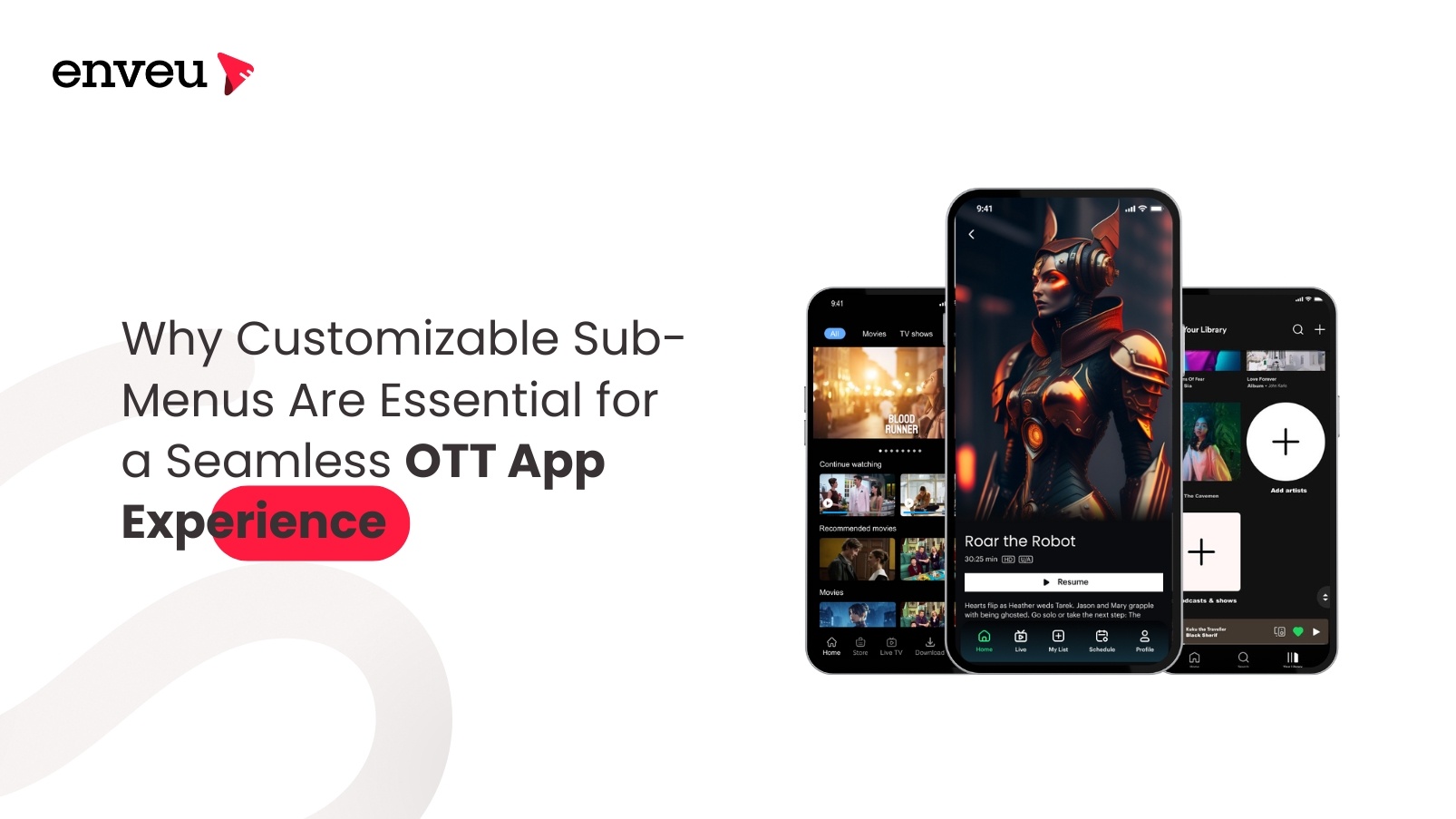Why Customizable Sub-Menus Are Key for a Seamless OTT Experience
Discover why customizable sub-menus enhance user experience in OTT apps, improving navigation, engagement, and content discovery for seamless streaming.

In today's speed-driven industries, Over-the-top (OTT) streaming services need seamless user experiences to maintain viewer loyalty. A menu system that organizes its content defines an intuitive interface in its fundamental aspects. Users benefit the most from the game-changing sub-menu customization feature, which enables easy navigation alongside new content discovery and deeper platform engagement. This blog investigates how customization improves the overall Over-the-Top streaming experience.
Why Is Intuitive Navigation Crucial for OTT Viewer Retention?
A large collection of titles on an OTT platform causes user frustration when the interface becomes difficult to navigate, which leads viewers to stop using the service. The organization of menu content supports effortless access to content availability in the system.
Sub-menu customization allows users to create their unique way of browsing, which shortens search time and develops better engagement. A smooth navigation system is essential for maintaining viewer loyalty on the platform.
How does Sub-Menus improve content discoverability through effective organization?
Any OTT platform with an extensive content collection needs proper organization to help users discover their desired titles effectively. A system of sub-menus organizes content materials through different categories, including genres, languages, trending subjects, or custom playlists.
The specific section organization facilitates user efficiency during browsing because it reveals intriguing content while ensuring a smooth viewing process.
What Role Do Customizable Sub-Menus Play in User Personalization?
Effective user engagement of the content viewers begins and ends with personalized experiences. To ensure smooth user journey, navigation settings can be customized through sub-menus, which allows businesses or content creators to offer personalized navigation based on their preferences.
Content consumers can set their preferred categories as priorities, create watchlists, and access content suggestions based on their viewing history. The platform obtains increased interaction and improved user satisfaction through its customizable sub-menu features.
How Can Sub-Menus Improve Accessibility and Convenience?
Users access OTT content via electronic devices, including smart TVs, smartphones, tablets, and desktops. The sub-menu system allows users to maintain consistent convenience on all available platforms via smooth navigation. Quick shortcuts combined with recently watched sections and folders allow for simplifying content discovery, reducing user friction, and assurance of engagement.
How Do Sub-Menus Aid in Content Monetization Strategies?
OTT platforms with free and paid content can use sub-menus as guiding tools that direct users toward their monetized sections. Sub-menu placement of premium content blocks pay-per-view elements, and featured ad-supported sections increase user exploration toward monetary content investments. Well-constructed menu navigation systems both simplify navigation and generate revenue at the same time.
How Can OTT Platforms Optimize Sub-Menus for Different Audiences?
Audiences demonstrate different ways of discovering content material. Users have different methods to find content, including browsing by genre, using recommendations, and viewing trending content.
The personalized layout of sub-menus helps platforms provide structured menus that meet audience requirements. Analysis of user activities enables platforms to upgrade sub-menu layout systems to deliver better targeted and satisfying user engagement.
What Are the Key Features of an Effective Sub-Menu System?
A sub-menu system reaches its maximal usability when it includes the following features:
- A sub-menu system that makes its category arrangements dynamic through user interaction and preference data.
- Systems utilize artificial intelligence algorithms to update menu structure by analyzing user viewing records.
- Ensuring seamless navigation across different devices.
- A user-friendly interface exists when menus display simple visual elements alongside straightforward navigation.
- Search and Filter Enhancements should include advanced functionalities with filters that let users narrow down their options.
- Users can use Custom Shortcuts and Bookmarks to create shortcuts for their favorite genres and specific content sections.
- Multi-Language Support.
How Do Customizable Sub-Menus Improve User Engagement Metrics?
An OTT platform's success depends heavily on engagement metrics, including session duration, the number of clicks, and the content consumption rate. The performance metrics of user engagement will improve through well-organized sub-menus since they enable easier user navigation to appropriate content. Online users spend more time on a platform when they encounter quick access to desired content.
How Can Sub-Menus Adapt to Changing Trends in OTT Consumption?
The OTT industry experiences ongoing transformation because viewer patterns shift while new content varieties appear. Platforms can use customizable sub-menus as an effective tool to meet emerging trends:
- OTT platforms should use their sub-menus to highlight relevant event content and seasonal material, including holiday specials and sports tournaments alongside award-winning movies.
- OTT platforms can generate visibility for trending content sections consisting of short-form videos, publisher clips, live e-streams, and podcasts.
- Most OTT platforms utilise live data from streaming to generate sections that alter their content accordingly.
How Can Data Analytics Enhance the Efficiency of Sub-Menus?
The sub-menu experience benefits greatly from data analytic applications. Tracking user actions allows platforms to understand what users prefer, browsing behaviors, and content consumption patterns.
- List categories that users often access in positions that stand out.
- Inspect areas where users abandon the menu interface to develop performance enhancements.
- Users should test different menu designs to find which approach works best.
How Enveu Simplifies Menu Management for OTT Platforms?
Enveu stands out for its exceptional backend platform, which enables effective menu management for streaming entertainment providers. The content management system (CMS) offered by Enveu gives OTT platforms tools to design sub-menus with complete flexibility and editing capabilities.
Through its specialized skills, Enveu assists OTT platforms to optimize their content search features, thus delivering better interaction and complete user interfaces.
Conclusion
Modern OTT platforms utilize customizable sub-menus as their key navigational feature to offer users structured and easy-to-use interfaces. The system improves user discovery capabilities and generates personalized recommendations, increasing accessibility and driving revenue growth. Combining optimized sub-menu systems with data analytics and Enveu solutions enables OTT platforms to improve their user experience, which drives both viewer retention and satisfaction in the long term.